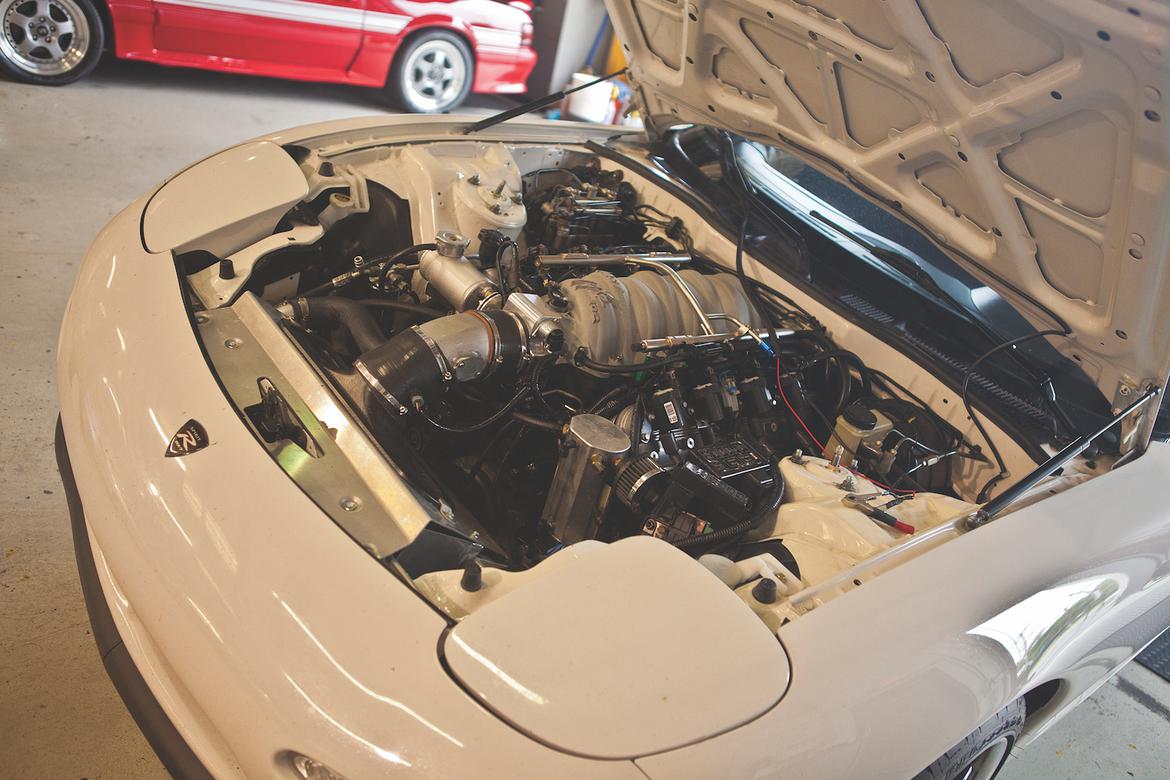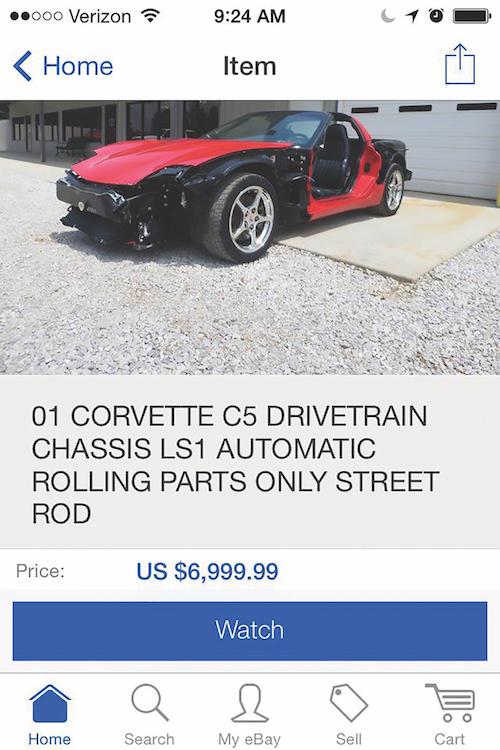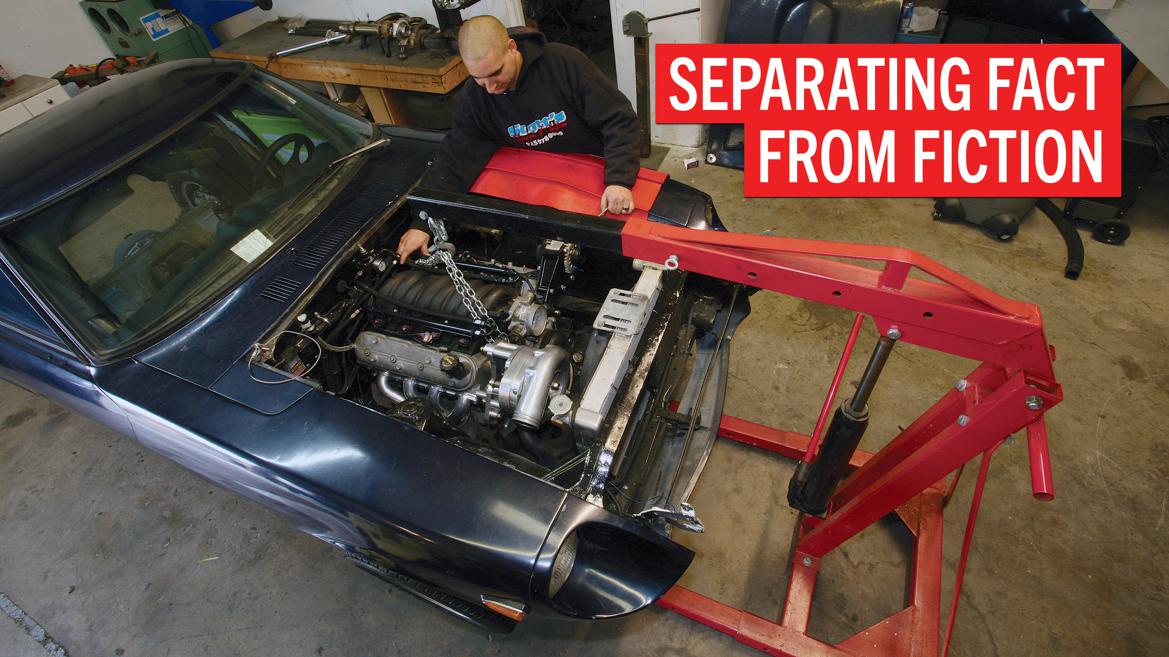The Internet is full of chatter about transplanting General Motors’s third- and fourth-generation V8s, engines commonly known by their LS designations. The biggest problem with these Internet claims isn’t that they’re outright lies, it’s that they’re just not true for everyone. A hotrodder at the top of the game is going to have a different result from a newbie wrenching in a parking lot.
Claim 1: An LS Swap Costs Less Than $1000

Photography Credit: Kevin Adolf
Reality: If your costs are this low, it means you scored an excellent deal on a parts car, recouped the price by selling off what was left of it (and possibly the engine you removed), fabricated any necessary adapters or brackets, welded your own exhaust, and adapted the donor car’s wiring harness. It also assumes that you didn’t need any rare or expensive parts, and that either your existing rear axle was stout enough to keep or your parts car had a worthy replacement.
Not able or willing to go so far to cut costs? A more realistic starting budget is around $1500 to $2000 for a basic swap using a common truck engine, factory exhaust manifolds, and your existing front crossmember and rear axle. Swaps that require fabricated oil pans, aftermarket crossmembers, or rear suspension overhauls can set you back considerably more.
Using a premium LS engine can also up the cost. Performing a basic Corvette engine swap in a Miata, for example, can increase that $1000 budget tenfold.
Claim 2: Swapping an LS for an Earlier GM V8 Is a Bolt-In Project

Photography Credit: Kevin Adolf
Reality: The only mounting points the LS shares with the older small-block Chevys are five of the six transmission bolts. Both engine types feature a rear-mounted oil sump as well. Those few similarities are all that separate one of these swaps from a Chrysler Hemi transplant. The accessory mounting brackets, radiator hoses, exhaust manifolds, engine mounts–they’re all completely different. That’s the bad news.
The good news? The aftermarket and the enthusiast community have discovered and thoroughly documented ways around these problems. For many common LS swaps, there’s a known combination of factory and aftermarket parts that can make the job pretty close to a bolt-in affair.
If you improvise–say, by using a slightly different combination of parts or a chassis that doesn’t have a well-known “recipe”–you may have to get out the Sawzall and welding torch. Even if you figure out your own bolt-together mounts, you’ll most likely need to weld up a custom exhaust system.
Claim 3: They Can Make a Ton of Power

Photography Credit: Kevin Adolf
Reality: Not all LS engines are created equal. The weakest ones–the 4.8-liter variants found in many 1999 and 2000 trucks–produced just 255 horsepower in stock form. Garden-variety 5.3-liter engines–the ones you’re most likely to run across–tend to make just shy of 300 horsepower. A cam swap–along with stiffer valve springs and a suitable ECU tune–can put them in the mid-300s depending on how aggressive you get with the cam and how much torque you’re willing to lose at the bottom end.
There are LS variants that make 400 or more horses in factory tune, but they tend to command a premium. If your budget is big enough, even more powerful, factory-supercharged versions are available.
Something to keep in mind: LS speed parts are often significantly more expensive than those for older Detroit engines, although the prices can be quite reasonable compared to late-model import engines. However, a few well-chosen performance parts can put an LS powerplant in the 450-pony range, and turbo builds can send the power figure into the stratosphere.
Time to Shop: Parts Donors
The LS engine family is large and widely varied. Whether you buy yours new or used, it pays to know the basic differences between engine donors. The accessory drive layouts are all quite similar. On the passenger side is a low-mounted a/c compressor, which often won’t clear frame rails and requires some sort of aftermarket mount. On the driver side is a power steering pump and an alternator. Parts like oil pans, exhaust manifolds and accessory drive parts swap between different variants, although sometimes one or two holes don’t line up if you play mix and match.
TRUCKS:

These are the most common donors you’ll find, and the popular 4.8- and 5.3-liter iron-block engines go for very little money. Some of the earliest versions feature iron cylinder heads, but the factory quickly switched to aluminum ones.
You can find a 4.8 with all its accessories in place for less than $500, while 5.3 engines are only a bit more expensive. Larger or more upscale trucks sometimes have 6.0-liter iron engines; these sell for a premium, as do the small number of aluminum-block truck engines.
While nicely priced, truck engines have two disadvantages. First, the 4.8 and 5.3 versions are the least powerful in the family: generally less than 300 horsepower stock.
The other drawback is packaging. These engines come with a tall intake manifold–which can cause hood clearance issues–a deep oil pan, and an alternator that sits above the cylinder heads.
The Trailblazer SS exhaust manifolds are a popular choice for tight engine compartments, and they’re available new for quite reasonable prices. They stick closely to the block and exit from the back, angled downward at about 45 degrees.
Van engines have a couple of cosmetic drawbacks: They’re missing the top cover found in truck versions, and the dipsticks slither around before undulating out of the front of the block. They also use a different power steering pump with a remote reservoir.
One of these may actually be preferable if you’re swapping it into an older van. For other applications, though, it can force you to buy a few more nickel-and-dime items.
CORVETTES:

In 1997, the Corvette became the first car to receive the LS engine. If you have the budget, this is the one you want.
Generally speaking, the most powerful versions of the LS were fitted into Corvettes. These engines use a much lower intake manifold that puts the throttle body just barely above the valve covers and below the coil pack covers. The oil pans are shallow, which can be helpful with clearance, but the sump extends farther forward than the ones used in the trucks. Corvette accessory mounts provide the most clearance in many applications as well.
The downside to the Corvette engines? You’ll likely pay a premium. eBay prices for complete Corvette engines range from a little less than $2000 for an early 5.7-liter LS1 to nearly 10 times that figure for the later variants. All Corvettes received drive-by-wire throttle bodies, too, which could add a little complexity to your swap.
CAMAROS AND FIREBIRDS:

The fourth-generation F-bodies were rated at 305 horsepower, but in reality these cars were equipped with 345-horsepower, 5.7-liter Corvette engines. They received few changes aside from the exhaust and a swap to a cable-operated throttle body.
Their accessories mount differently, though: The alternator sits low and the power steering pump high. The Corvette engines offer more clearance, although the Camaro and Firebird oil pans are about as shallow as the ones in the Vette.
As with the Corvette, all F-bodies feature aluminum blocks, and they command a premium over the iron truck engines. Figure about $3000 for one on eBay.
When Chevy brought back the Camaro in 2010, they bumped the V8’s horsepower to 400 minimum. These LS3, 6.2-liter engines also have one of the best exhaust manifold setups for tight engine compartments, featuring close, block-hugging manifolds and simple, two-bolt flanges that exit straight down. Their accessory mounting setup is similar to that in older Camaros, with a low alternator and high power steering pump.
LS3 prices hover around $6000 on eBay. The 6.2-liter LS7 found in the supercharged Camaros is a rare bird on the used market, but we’ve seen it trade hands in the high teens.
GM FULL-SIZE:

Other rear-wheel-drive passenger cars use an accessory setup similar to the Camaro’s and make similar amounts of power. These cars include the Pontiac GTO and G8 GXP as well as the Cadillac CTS-V.
The 2009-and-later Cadillac CTS-V is a standout, as it uses a supercharged LSA that puts out 556 horsepower–budget mid-teens for that one. Many of the other passenger cars use slightly deeper oil pans than those found in the late Camaro.
CHEVY IMPALA SS, PONTIAC GRAND PRIX GXP AND RELATIVES:

The front-wheel-drive, 5.3-liter General Motors V8, called the LS4, is a rare engine that deserves special mention. Its bolt pattern doesn’t match the rear-drive LS engines’, although it is shared with the 60-degree GM V8 and the front-drive Buick V6. The LS4 also uses a shortened water pump and unique accessory mounts.
Thanks to its uniqueness, the LS4 is a poor choice for a typical front-engine, rear-drive swap. On the other hand, it could be perfect for a V8-powered, front-drive swap or a mid-engined Fiero. Like all other passenger car applications, it uses an aluminum block.
What Else Do You Need For Your LS Swap?

Photography Credit: Kevin Adolf
MOUNTING THE ENGINE
The LS engine isn’t just going to jump into the engine bay and come to life. You’re going to need to tackle some of the details, too.
The LS engine mounts bolt onto the side of the block. There are a number of adapter plates that easily mate earlier Chevy V8 mounts to the side of the LS block, but take note: Plates that put the mounts in the factory locations won’t let you keep the LS engine’s a/c compressor.
The aftermarket has bolt-in mounts for some of the most common swaps, but for more oddball projects, get ready to do some welding.
Some swaps, particularly into four-wheel-drive vehicles or cars designed for an engine with a front-sump oil pan, will have clearance issues with the engine crossmember or steering. If you’re lucky, you can solve these problems by changing to a different oil pan. Swapping from a truck oil pan to a passenger car pan typically buys you around 3 inches of clearance at the sump. If you’re not lucky, this swap can require an aftermarket replacement part or modifications to the crossmember.
Accessories can also cause clearance issues, and the a/c compressor location tends to be the most problematic. There are several kits out there that relocate the a/c compressor higher and to the outside of the passenger-side cylinder head. If you need to relocate the alternator or power steering pump, there are options for that as well.
The most straightforward transmission option is one that came paired with an LS engine. When looking for a manual box, note that the New Venture truck transmissions have widely spaced gearing that is more suited to towing than performance driving. The Tremec transmissions used in most passenger cars are a better choice for a sports car.
For automatics, GM used a 4L60E or the slightly stronger 4L65E for most trucks and passenger cars; a heavy-duty version, the 4L80E, was fitted in larger trucks. A few applications also received a six-speed automatic. LS-powered Corvettes have a rear-mounted transaxle that only makes sense to swap over if you’re into fabrication challenges.
MAKING IT RUN
All factory LS engines come with fuel injection and a crank-fired, coil-per-plug ignition. Many swappers with relatively stock engines opt to use a stock ECU–usually with a chip that defeats the factory anti-theft system.
The wiring harnesses typically require a fair amount of reworking, though, since a number of unrelated chassis wires are usually mixed in. The aftermarket offers swap-friendly harnesses to make this easier.
Those looking for more in-depth tuning capabilities can opt for an aftermarket standalone ECU, many of which support these engines. Note that the 4L60E and 4L80E transmission require electronic control as well–either a stock ECU or an aftermarket option.
If you have a fear of electronics, you can still replace the intake with an aftermarket carbureted piece. However, putting a distributor on one of these engines is not easy–or, in most cases, at all worthwhile. MSD makes a purpose-built ignition control box for these sorts of applications. Some swappers looking for other options use a MicroSquirt ECU as an ignition controller, although this route isn’t much simpler than using one to run fuel and ignition together.
ACCESSORIES AND OTHER SYSTEMS
Exhaust systems often need to be custom-made.
You may be able to find an off-the-shelf molded hose for some other application that is close enough to fit your swap.
Throttle cables for carbureted engines are often too short for factory LS intakes; a mountain bike brake cable can work here for a much lower price than cables sold for engine swaps.
Many truck engines have provisions for oil coolers. Unless you have a cooler built into the radiator or an oil thermostat, you’ll want to use a block-off plate.
If you’re swapping an LS into something that previously had a V8 or a fairly stout six, you may not have much left to do besides find a suitable driveshaft. Putting a V8 into a car designed for less torque, however, is likely to grenade the rear axle. Source a tougher axle–or differential and half-shafts–in this case.
With any engine swap, it’s hard to predict all the little parts you’ll need until the engine is sitting in the engine bay. Make sure to leave a bit of room in the budget for these details.












































